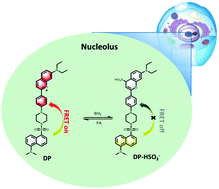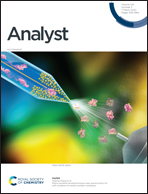A ratiometric fluorescent probe for reversible monitoring of endogenous SO2/formaldehyde in cytoplasm and nucleoli regions and its applications in living mice†
Abstract
The excessive production of sulfur dioxide (SO2) and formaldehyde (FA) by organisms is closely associated with several diseases, including neurological disorders, respiratory disease, and genotoxicity. RNA plays a central role in the expression of genes. However, it is difficult for fluorescent probes to explore the intersecting correlation of SO2 and FA near the nucleolus regions due to the protective obstacle of the cell nucleus membrane. Herein, a unique fluorescent probe (DP) for reversible detection of the interaction of SO2 and FA in the nucleolus regions was constructed. In light of the outstanding attributes of DP, including a large fluorescence ratio variation, ultrafast detection of SO2, and excellent reversibility, it was successfully employed to track the variation of endogenous SO2 and FA in the cytoplasm and nucleolus regions of live cells. In addition, the DP probe could be applied to the imaging of endogenous SO2 and then recovered by FA in live mice.



 Please wait while we load your content...
Please wait while we load your content...